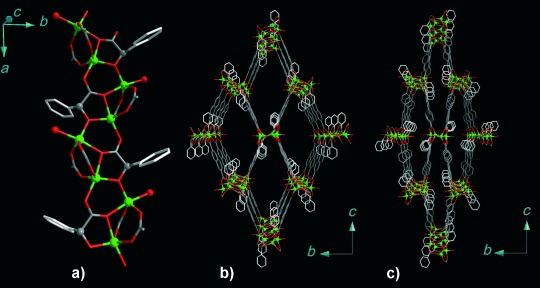Modular Homochiral Porous Coordination Polymers: Rational Design, Enantioselective Guest Exchange Sorption and Ab Initio Calculations of Host-Guest Interactions
슈퍼관리자
2021-05-21
Modular Homochiral Porous Coordination Polymers: Rational Design, Enantioselective Guest Exchange Sorption and Ab Initio Calculations of Host-Guest Interactions
-
Authors :
D. N. Dybtsev, M. P. Yutkin, D. G. Samsonenko, V. P. Fedin, A. L. Nuzhdin, A. A. Bezrukov, K. P. Bryliakov, E. P. Talsi, R. V. Belosludov, H. Mizuseki, Y. Kawazoe, O. S. Subbotin, and V. R. Belosludov
-
Journal :
Chem. Eur. J.
-
Vol :
16
-
Page :
10348-10356
-
Year :
2010

Abstract
Two new, homochiral, porous metal–organic coordination polymers [Zn2(ndc){(R)‐man}(dmf)]⋅3DMF and [Zn2(bpdc){(R)‐man}(dmf)]⋅2DMF (ndc=2,6‐naphthalenedicarboxylate; bpdc=4,4′‐biphenyldicarboxylate; man=mandelate; dmf=N,N′‐dimethylformamide) have been synthesized by heating ZnII nitrate, H2ndc or H2bpdc and chiral (R)‐mandelic acid (H2man) in DMF. The colorless crystals were obtained and their structures were established by single‐crystal X‐ray diffraction. These isoreticular structures share the same topological features as the previously reported zinc(II) terephthalate lactate [Zn2(bdc){(S)‐lac}(dmf)]⋅DMF framework, but have larger pores and opposite absolute configuration of the chiral centers. The enhanced pores size results in differing stereoselective sorption properties: the new metal–organic frameworks effectively and stereoselectively (ee up to 62 %) accommodate bulkier guest molecules (alkyl aryl sulfoxides) than the parent [Zn2(bdc){(S)‐lac}(dmf)]⋅DMF, while the latter demonstrates decent enantioselectivity toward precursor of chiral anticancer drug sulforaphane, CH3SO(CH2)4OH. The new homochiral porous metal–organic coordination polymers are capable of catalyzing a highly selective oxidation of bulkier sulfides (2‐NaphSMe (2‐C10H7SMe) and PhSCH2Ph) that could not be achieved by the smaller‐pore [Zn2(bdc){(S)‐lac}(dmf)]⋅DMF. The sorption of different guest molecules (both R and S isomers) into the chiral pores of [Zn2(bdc){(S)‐lac}(dmf)]⋅DMF was modeled by using ab initio calculations that provided a qualitative explanation for the observed sorption enantioselectivity. The high stereo‐preference is accounted for by the presence of coordinated inner‐pore DMF molecule that forms a weak CH⋅⋅⋅O bond between the DMF methyl group and the (S)‐PhSOCH3 sulfinyl group.















